Temporal and Spatial Evolution Laws of Freezing Temperature Field in the Inclined Shaft of Water-Rich Sand Layers
Abstract
:1. Introduction
2. Project Background
2.1. Engineering Geology and Hydrogeology
2.2. Design of Freezing and Monitoring Scheme
3. Three-Dimensional Freezing Temperature-Field Calculation Model
3.1. Mathematical Model of 3D Freezing Temperature Field
3.2. Establishment of a 3D Finite Element Numerical Model
- (1)
- Soil mass is a saturated porous medium composed of soil particles, water and ice.
- (2)
- All parts of soil mass are homogeneous and isotropic.
- (3)
- In the freezing process, convective heat transfer caused by groundwater seepage is not considered.
- (4)
- In the freezing process, the influence on the temperature field of frost heaving is not considered [23].
3.3. Thermal Physical Parameters of Soil
3.4. Initial Temperature and Boundary Conditions
4. Measured Data of the Temperature Field in the Open-Excavation Section
5. Analysis of Numerical Results
5.1. Comparison of Simulation Results
5.2. Spatiotemporal Evolution Law of the Temperature Field before Excavation
5.2.1. Overall Distribution and Development Law of the Temperature Field
5.2.2. Average Temperature and Thickness of the Effective Freezing Wall
5.2.3. Temporal and Spatial Evolution Laws of the Temperature Field along Main Pathways
5.3. Evolution Law of the Temperature Field during Excavation Period
5.3.1. Excavation Methods
5.3.2. Analysis of the Temperature-Field Cloud Diagram during Excavation Period
5.3.3. Well Wall Temperature during Excavation Period
6. Conclusions
- (1)
- The field measured data revealed that the initial ground temperature of the fine sand layer was approximately 3.7 °C lower than that of the medium sand layer, resulting in a higher freezing rate for the fine sand layer compared with that of the medium sand layer. Due to the sealing effect of the frozen wall, the fine and medium sand layers at the T1 temperature measurement holes experienced freezing for 13 to 27 days, with phase change platforms appearing sequentially. However, there was no evident phase change platform in the soil at the T3 temperature measurement holes. During the 50-to-60-day freezing period, the overall temperatures of the soil on both sides of the point decreased to approximately −20 °C and −8 °C, respectively. Subsequently, the soil temperature stabilized.
- (2)
- Under the same freezing time, the average temperature and effective frozen wall thickness, as per the numerical simulation results, showed that freezing was more efficient in the fine sand layer than in the medium sand layer. Both the numerical calculations and field measurements showed that, after 88 days of freezing, the average temperature of the frozen wall for each soil layer was lower than −12 °C. The thickness of the frozen wall could reach over 4 m for the side walls of different layers and over 5 m for the bottom plate. Consequently, it was found to be reasonable and safe to excavate the open-excavation section after 88 days of freezing.
- (3)
- A partial-step excavation method was employed for the excavation area of the open-excavation section, involving six excavation steps. During soil excavation, the section was exposed, and the freezing pipes were suspended for cooling. The soil experienced “heat flow erosion,” resulting in an increase in the temperature at the well side. However, this temperature rise was limited, and the well-side temperature could still maintain a low negative level with a quick cooling recovery from the freezing pipes. This prevented spalling at the well side, and the effective thickness of the frozen wall did not decrease. The average temperature of the frozen wall remained below −10 °C. Consequently, there was no extensive “softening” of the frozen wall during the excavation process, ensuring construction safety.
Author Contributions
Funding
Institutional Review Board Statement
Informed Consent Statement
Data Availability Statement
Conflicts of Interest
References
- Pimentel, E.; Papakonstantinou, S.; Anagnostou, G. Numerical interpretation of temperature distributions from three ground freezing applications in urban tunnelling. Tunn. Undergr. Space Technol. 2012, 28, 57–69. [Google Scholar] [CrossRef]
- Kang, Y.; Hou, C.; Li, K.; Liu, B.; Sang, H. Evolution of temperature field and frozen wall in sandy cobble stratum using LN2 freezing method. Appl. Therm. Eng. 2021, 185, 116334. [Google Scholar] [CrossRef]
- Yuan, Y.; Liu, Z.H.; Zhu, C.; Yuan, C.F.; Wang, S.Z. The effect of burnt rock on inclined shaft in shallow coal seam and its control technology. Energy Sci. Eng. 2019, 7, 1882–1895. [Google Scholar] [CrossRef]
- Hu, X.; Hong, Z.; Fang, T. Analytical solution to steady-state temperature field with typical freezing tube layout employed in freeze-sealing pipe roof method. Tunn. Undergr. Space Technol. 2018, 79, 336–345. [Google Scholar] [CrossRef]
- Wang, B.; Rong, C.; Cheng, H.; Cai, H. Experimental investigation on heat transfer law of multiple freezing pipes in permeable stratum with high seepage velocity. Int. J. Heat Mass Transf. 2022, 182, 121868. [Google Scholar] [CrossRef]
- Zhelnin, M.; Kostina, A.; Prokhorov, A.; Plekhov, O.; Semin, M.; Levin, L. Coupled thermo-hydro-mechanical modeling of frost heave and water migration during artificial freezing of soils for mineshaft sinking. J. Rock Mech. Geotech. Eng. 2022, 14, 537–559. [Google Scholar] [CrossRef]
- Ma, Q.; Huang, K.; Ma, D. Energy absorption characteristics and theoretical analysis of frozen clay with pre-existing cracks under uniaxial compressive impact load. Cold Reg. Sci. Technol. 2021, 182, 103206. [Google Scholar] [CrossRef]
- Wang, Q.; Yang, W.; Wang, Y. Study on concrete strain of inclined shaft lining in deep alluvium during freezing sinking period. J. Min. Saf. Eng. 2016, 33, 655. [Google Scholar]
- Yang, R.; Wang, Q.; Yang, L. Closed-form elastic solution for irregular frozen wall of inclined shaft considering the interaction with ground. Int. J. Rock Mech. Min. Sci. 2017, 100, 62–72. [Google Scholar] [CrossRef]
- Chen, Z.-y.; Zhang, Y.; Lu, L. Simulation Experiment Study on Freezing Temperature Field of Mine Axial Freeing Inclined Shaft. Coal Sci. Technol. 2013, 41, 46–49. [Google Scholar]
- Zhou, T.; Zhou, G. Calculation method of frozen soil wall thickness for inclined shaft in consideration of the shaft inclination. J. China Univ. Min. Technol. 2016, 45, 514–520. [Google Scholar]
- Yang, R.; Wang, Q. Method of numerical simulations for inclined shaft freezing sinking. Sci. Technol. Rev. 2015, 33, 38–43. [Google Scholar]
- Yong, W.; Weihao, Y. Study on mechanical law of freezing inclined shaft lining intopsoil during frozen wall thawing. Coal Sci. Technol. 2016, 44, 133–139. [Google Scholar]
- Sun, J.; Ren, J. Physical Simulation Test on Temperature Field Distribution of Artificial Vertical Straight Multirow Freezing Inclined Shaft. Geofluids 2021, 2021, 5574713. [Google Scholar] [CrossRef]
- Sun, J.; Chen, X.; Qiu, M.; Cao, X.; Chen, S. Physical Model Test of Artificial Freezing-Inclined Shaft. Adv. Civ. Eng. 2021, 2021, 6640722. [Google Scholar] [CrossRef]
- Chen, J.; Zhang, X.; Wang, Q.; Zhao, K. Temperature fields in inclined shaft artificial freezing model tests of two freezing modes. Coal Eng. 2022, 54, 105–110. [Google Scholar]
- Zhang, C.; Zhang, Y.; Yang, W.; Li, H.; Lu, Q. Study on Temperature Field Evolution and Frozen Wall Closure Judgment Criteria of Inclined Shaft under Inclined Holes Freezing Condition. Geofluids 2022, 2022, 8002667. [Google Scholar] [CrossRef]
- Hu, X.-d.; Han, L.; Han, Y.-g. Analytical solution to temperature distribution of frozen soil wall by multi-row-piped freezing with the boundary separation method. Appl. Therm. Eng. 2019, 149, 702–711. [Google Scholar] [CrossRef]
- Lai, Y.; Liu, S.; Wu, Z.; Yu, W. Approximate analytical solution for temperature fields in cold regions circular tunnels. Cold Reg. Sci. Technol. 2002, 34, 43–49. [Google Scholar] [CrossRef]
- Vitel, M.; Rouabhi, A.; Tijani, M.; Guérin, F. Thermo-hydraulic modeling of artificial ground freezing: Application to an underground mine in fractured sandstone. Comput. Geotech. 2016, 75, 80–92. [Google Scholar] [CrossRef]
- Cai, H.; Xu, L.; Yang, Y.; Li, L. Analytical solution and numerical simulation of the liquid nitrogen freezing-temperature field of a single pipe. AIP Adv. 2018, 8, 055119. [Google Scholar] [CrossRef]
- Chen, Z.; Guo, X.; Shao, L.; Li, S.; Gao, L. Sensitivity analysis of thermal factors affecting the nonlinear freezing process of soil. Soils Found. 2021, 61, 886–900. [Google Scholar] [CrossRef]
- Liang, X.; Ye, F.; Feng, H.; Han, X.; Wang, S.; Zhang, B.; Gu, B. Temperature field spatio-temporal law and frozen-depth calculation of a tunnel in a seasonally frozen region. Cold Reg. Sci. Technol. 2022, 198, 103539. [Google Scholar] [CrossRef]
- Zhang, C.; Li, D.; Chen, J.; Chen, G.; Yuan, C.; Wang, Z.; Ding, G.; Chen, X.; Xia, M.; Wang, S.; et al. Research on the Temperature Field and Frost Heaving Law of Massive Freezing Engineering in Coastal Strata. Adv. Mater. Sci. Eng. 2021, 2021, 5575940. [Google Scholar] [CrossRef]
- Fu, Y.; Hu, J.; Wu, Y. Finite element study on temperature field of subway connection aisle construction via artificial ground freezing method. Cold Reg. Sci. Technol. 2021, 189, 103327. [Google Scholar] [CrossRef]
- Zhang, H.; Zhang, J.; Zhang, Z.; Zhang, M.; Cao, W. Variation behavior of pore-water pressure in warm frozen soil under load and its relation to deformation. Acta Geotech. 2020, 15, 603–614. [Google Scholar] [CrossRef]
- Long, W.; Rong, C.; Shi, H.; Huang, S.; Wang, Z.; Duan, Y.; Ma, H. Temperature Field and Stability Analysis of the Frozen Wall Based on the Actual Position of Freezing Holes. Appl. Sci. 2022, 12, 8943. [Google Scholar] [CrossRef]
- Fan, W.; Yang, P. Ground temperature characteristics during artificial freezing around a subway cross passage. Transp. Geotech. 2019, 20, 100250. [Google Scholar] [CrossRef]

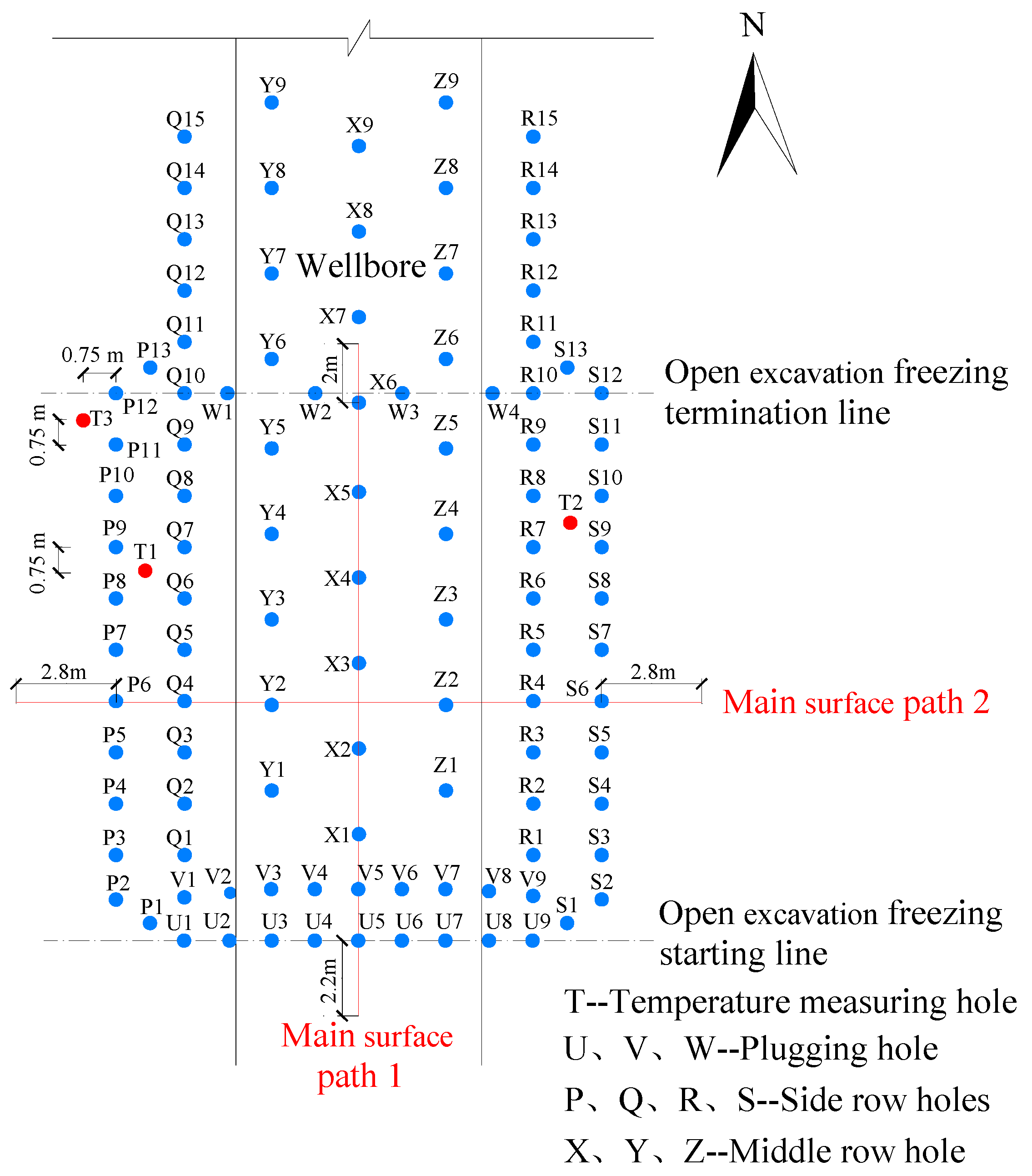

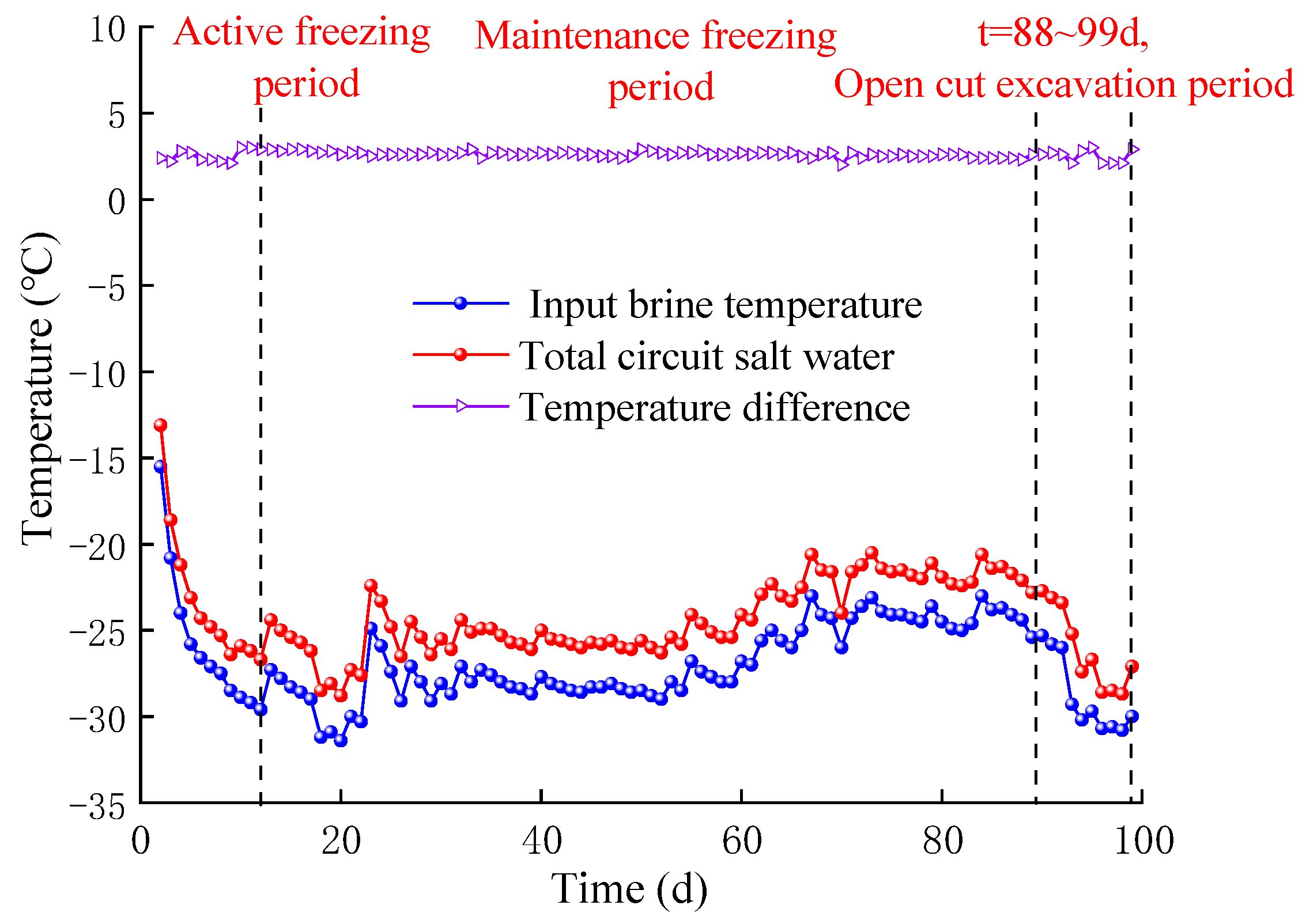
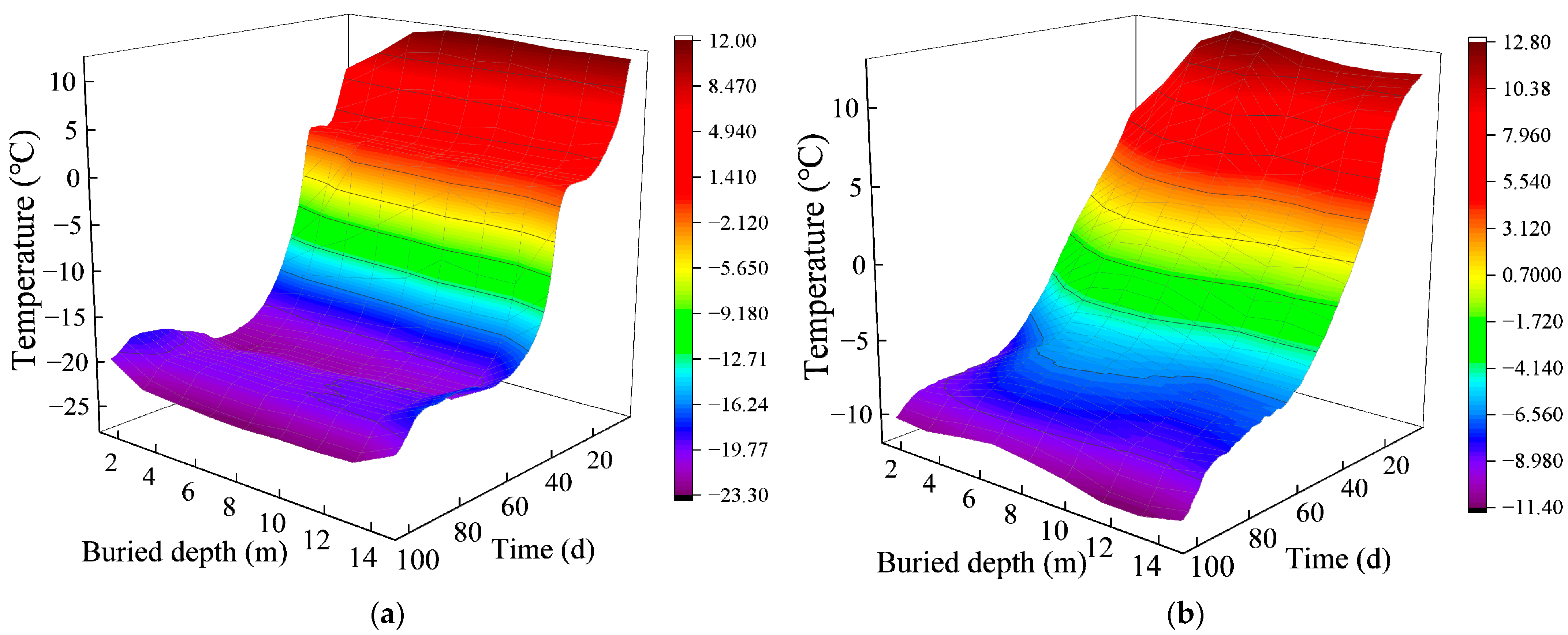
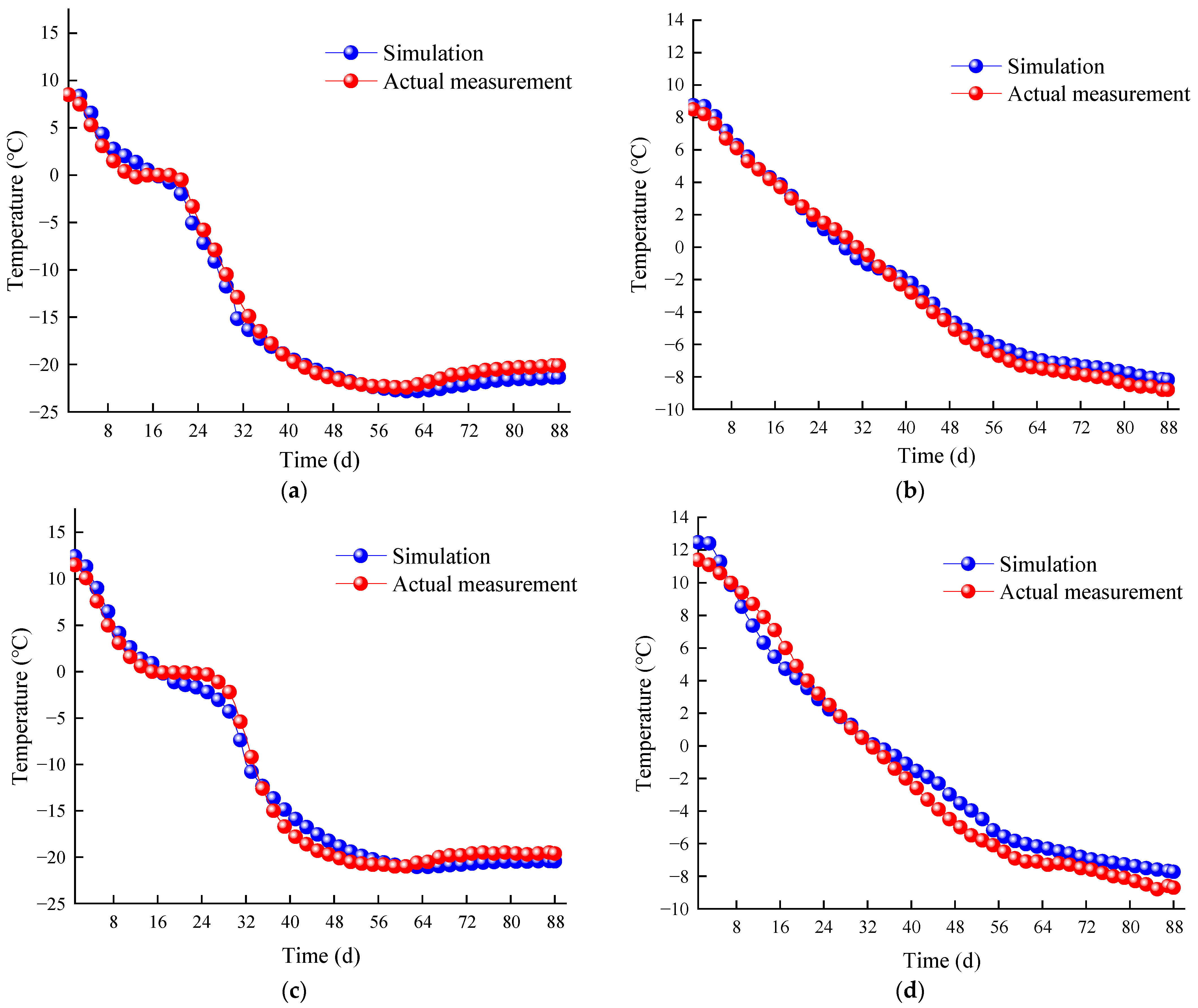


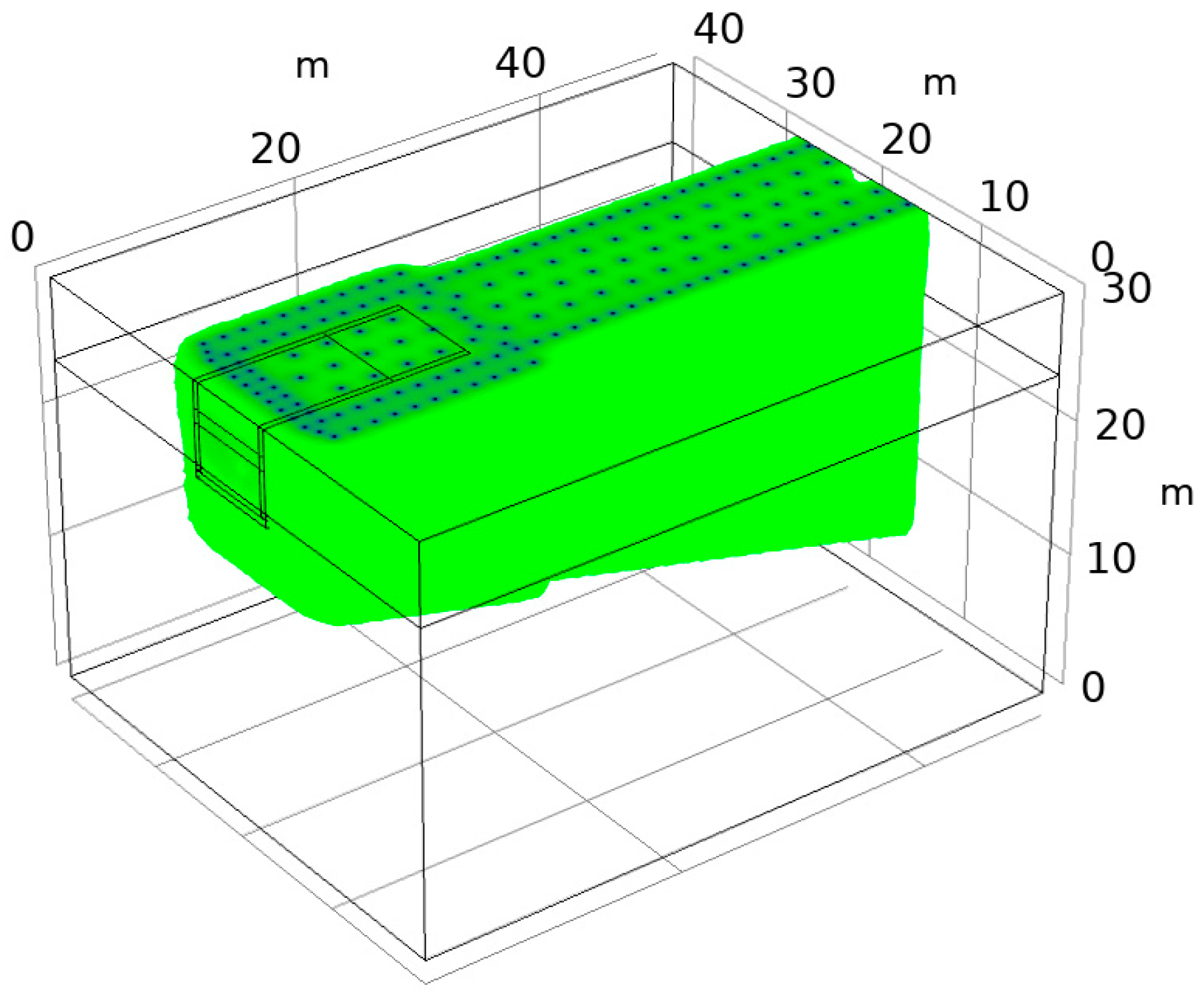
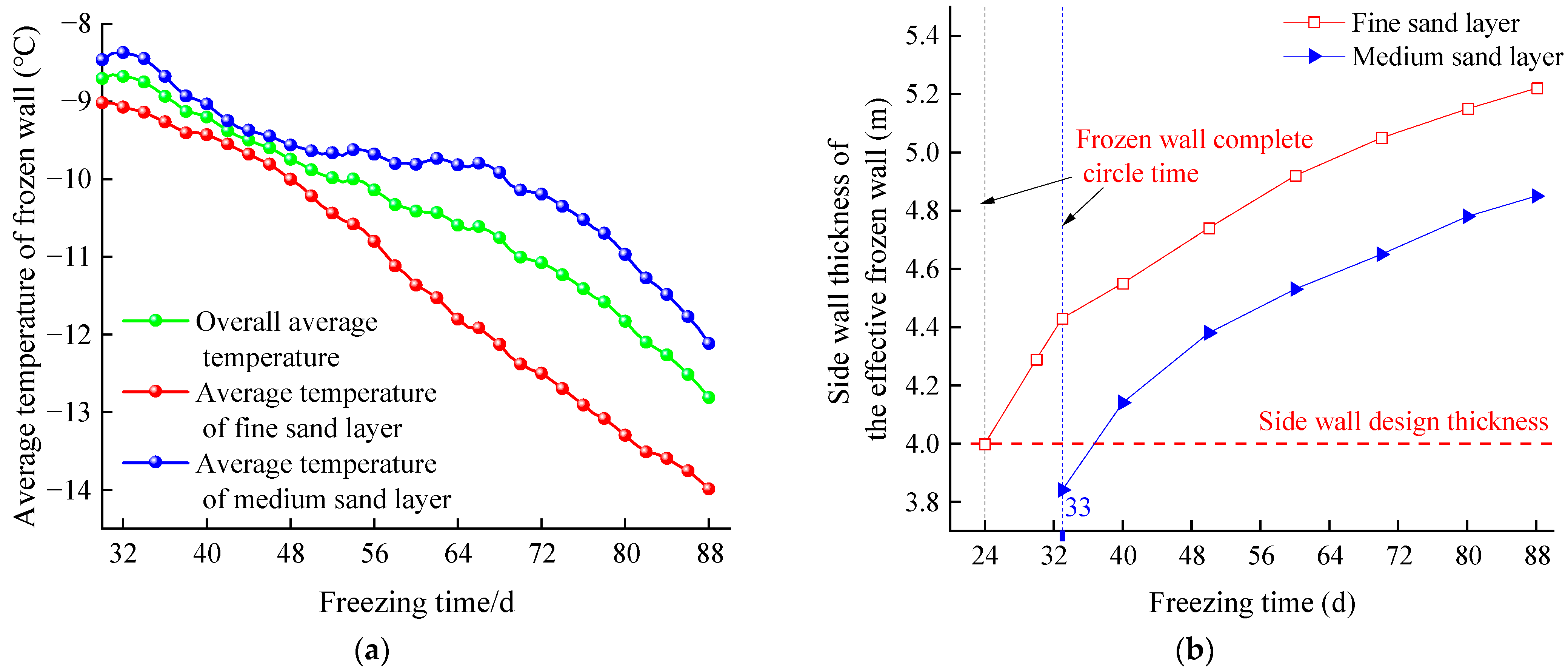
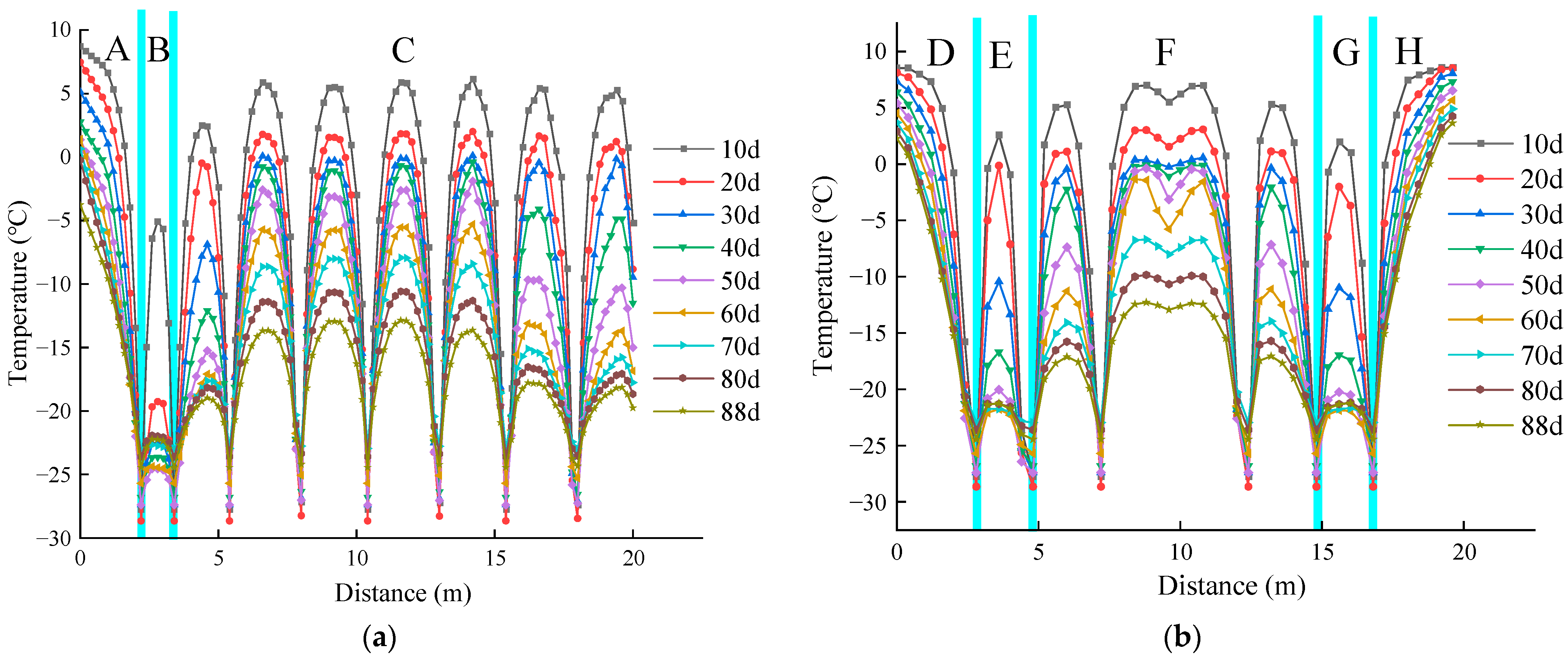



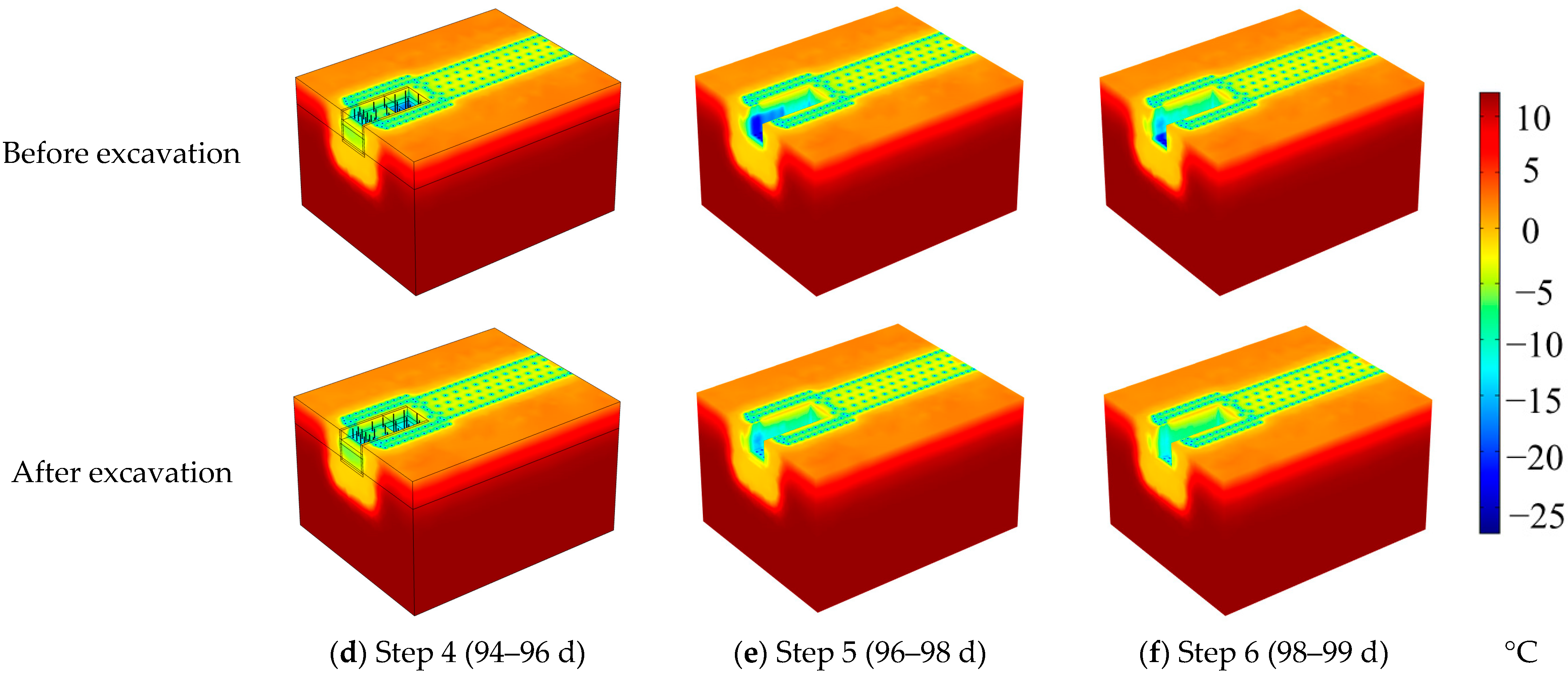
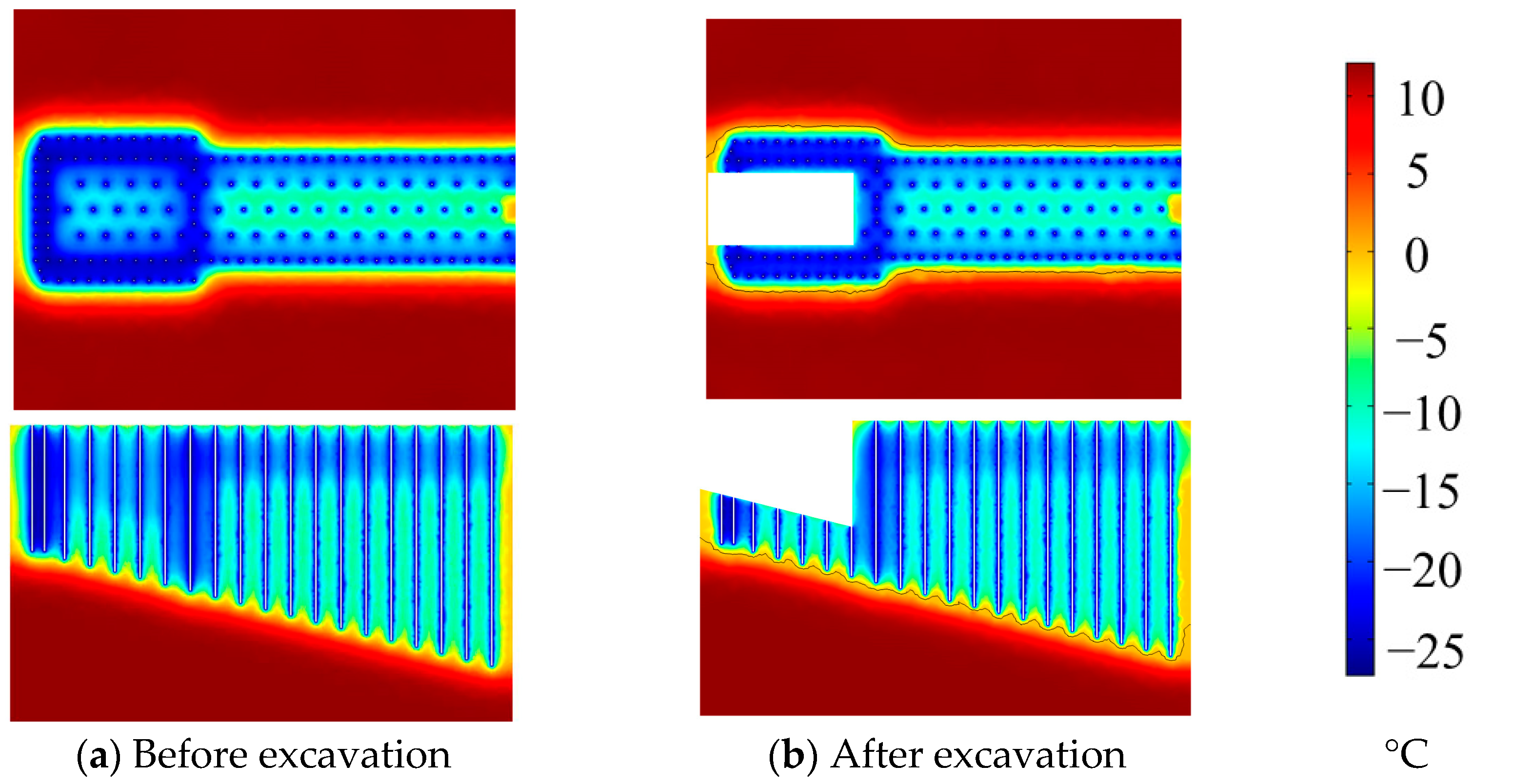
| Types of Freezing Holes | Depth/m | Diameter of Frozen Pipes/mm | Number of Holes |
|---|---|---|---|
| Plugging holes | 12.5–15.5 | Ф140 | 22 |
| Middle-row holes | 12.5–15.5 | Ф108/Ф140 | 16 |
| Side-row holes | 12.5–15.5 | Ф140 | 46 |
| Soil Properties | Depth of Embedment/m | Specific Heat Capacity of Unfrozen Soil/ (J·g−1·K−1) | Specific Heat Capacity of Frozen Soil/ (J·g−1·K−1) | Thermal Conductivity of Unfrozen Soil/ (W m−1·K−1) | Coefficient of Thermal Conductivity of Frozen Soil/ (W m−1·K−1) |
|---|---|---|---|---|---|
| Fine sand | 0–4.75 | 1.304 | 1.241 | 1.335 | 1.624 |
| medium sand | 4.75–25.91 | 1.424 | 1.181 | 1.305 | 1.854 |
| Excavation Steps | Temperatures on the Well Side along Different Directions/°C | ||||||||
|---|---|---|---|---|---|---|---|---|---|
| East Roof | East Waist Line | East Floor | South Roof | South Waist Line | South Floor | North Roof | North Waist Line | North Floor | |
| Step 1 (88 d) | −11.7 | −12.5 | −16.0 | −14.4 | −14.9 | −15.5 | −10.5 | −14.4 | −15.1 |
| Step 2 (89 d) | −12.1 | −14.1 | −14.2 | ||||||
| Step 3 (93 d) | −12.4 | −13.2 | −14.3 | ||||||
| Step 4 (94 d) | −12.0 | −13.1 | −13.1 | ||||||
| Step 5 (96 d) | −11.5 | −13.0 | −12.0 | ||||||
| Step 6 (98 d) | −11.1 | −12.0 | −12.8 | −11.5 | −11.7 | −10.6 | |||
Disclaimer/Publisher’s Note: The statements, opinions and data contained in all publications are solely those of the individual author(s) and contributor(s) and not of MDPI and/or the editor(s). MDPI and/or the editor(s) disclaim responsibility for any injury to people or property resulting from any ideas, methods, instructions or products referred to in the content. |
© 2023 by the authors. Licensee MDPI, Basel, Switzerland. This article is an open access article distributed under the terms and conditions of the Creative Commons Attribution (CC BY) license (https://creativecommons.org/licenses/by/4.0/).
Share and Cite
Zhang, J.; Wang, B.; Rong, C.; Long, W.; Yu, S. Temporal and Spatial Evolution Laws of Freezing Temperature Field in the Inclined Shaft of Water-Rich Sand Layers. Appl. Sci. 2023, 13, 8874. https://doi.org/10.3390/app13158874
Zhang J, Wang B, Rong C, Long W, Yu S. Temporal and Spatial Evolution Laws of Freezing Temperature Field in the Inclined Shaft of Water-Rich Sand Layers. Applied Sciences. 2023; 13(15):8874. https://doi.org/10.3390/app13158874
Chicago/Turabian StyleZhang, Jie, Bin Wang, Chuanxin Rong, Wei Long, and Shengmin Yu. 2023. "Temporal and Spatial Evolution Laws of Freezing Temperature Field in the Inclined Shaft of Water-Rich Sand Layers" Applied Sciences 13, no. 15: 8874. https://doi.org/10.3390/app13158874
APA StyleZhang, J., Wang, B., Rong, C., Long, W., & Yu, S. (2023). Temporal and Spatial Evolution Laws of Freezing Temperature Field in the Inclined Shaft of Water-Rich Sand Layers. Applied Sciences, 13(15), 8874. https://doi.org/10.3390/app13158874






